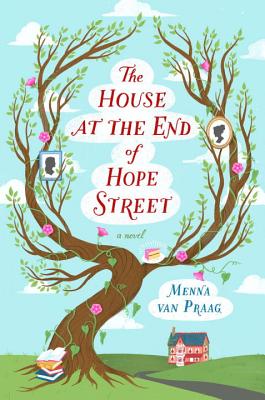The House at the End of Hope Street
by Menna van Praagh
“The house has stood at the end of Hope Street for nearly two hundred years.” So begins Menna van Praag’s debut novel. In those opening pages, nineteen-year-old Cambridge doctoral student Alba Ashby, reeling from an unnamed “worst event in [her] life,” is inexplicably drawn to the house. Alba is more than an academic over-achiever. She sees things that others can’t: ghosts and auras, but also vibrant and colorful scents and sounds. She immediately senses that this house is different.
Welcomed in by Peggy, the house’s elderly caretaker, she’s told, “You can stay here for ninety-nine nights, until the seventh of August, just before midnight. And then you must go… No rent, no bills. Your room will be your own, to do with as you like. But take care of the house and it’ll take care of you.” This last is an understatement. The house at the end of Hope Street is a veritable Hogwartsian Room of Requirement. When you’re sad and lean against the wall, it softens to comfort you. When you want to draw, a notebook materializes. You get the idea.
The tale opens with Alba, but eventually it proves to be an ensemble fantasy, as readers meet the other inhabitants of the house. There’s Peggy, of course, as well as an aspiring singer, Carmen, and actress, Greer. Each woman gets her ninety-nine days for healing, for reinvention, for whatever it is she needs. And this has been going on for two centuries. All over the house are framed photos of illustrious and accomplished ladies: Florence Nightingale, Daphne du Maurier, Vita Sackville West, Beatrix Potter, and dozens of others. (Don’t worry that you won’t recognize all the names—such as Elizabeth Garrett Anderson, the first female doctor in England—there’s a handy guide to all the ladies at the novel’s end.) These women are more than the house’s history; they’re a part of its present. Their photographs speak and frequently advise the house’s current tenants. It’s just that kind of place. Okay, so that’s the set up. I’ll leave the actual plot for you to uncover.
The reason I actually decided to take a chance on this book is that Ms. Van Praag was compared to so many authors whose work I loved: Jasper Fforde, Sarah Addison Allen, Alice Hoffman. I’d say that Addison Allen is the most apt comparison, and that fans of her light, magical realism-filled novels are likely to enjoy this. I don’t believe that van Praag’s prose is up to par with Ms. Hoffman’s lush writing. And Jasper Fforde was, for me, the strangest and most disappointing comparison. While it’s true that many classic literary figures make an appearance in the novel’s pages, this book contains none of the wit and great humor that is such a feature of his work. Overall, I’d describe this as gentle women’s fiction with a fantastic edge.
As the paragraph above indicates, I had a mixed response to the novel. I’m not going to lie… I had issues with Alba. “Every day she went to the library at the same time. Every day she bought her lunch at the same café and ordered the same thing.” This character is not just boring and repressed; she’s painfully shy and incredibly passive. When confronting a person who has wronged her terribly, she’s “barely audible.” Again and again I found myself wanting to slap this little mouse. And this is something I see in fiction all the time. An author who wants to show growth creates a character that is so damaged and diminished that it’s hard to care about her. (Kinder, gentler readers may well disagree with me on this.)
In general, I found the characters of the novel to be fairly one-dimensional. Alba has siblings, for instance, that are so cold and uncaring that they in no way resemble real human beings. And another thing—if you use historic figures like Dorothy Parker and Sylvia Plath as characters, write them dialogue that sounds like it might come out of their mouths. Give Parker a witty line, for God’s sake! Give Plath some poetry!
On the other hand, one of the great pleasures of the novel is the bibliophily on display throughout.
Alba is a serious book lover, her one redeeming quality. I thoroughly enjoyed her ruminations on literature. And even if they weren’t well-characterized, the extensive literary cast and references were great fun. I’ve always said that you can’t go wrong preaching to the choir. The story, in general, is entertaining and it all moves quickly. Also, Ms. van Praag did manage to surprise me with a few fun plot twists I didn’t see coming. And I actually quite enjoyed the theme of female empowerment, as exemplified by the house’s past tenants. The other thing that van Praag handled well was the novel’s resolution. While I felt frustration with certain elements of the tale, I have no complaints about the ending. It was the feel-good fix I was looking for.
So, all in all, a mixed bag. I’m happy enough to have read the book. It was quick and not overly challenging. In other words, not a bad way to pass a day. And the great thing about debut novels? The authors are still learning and growing. Who knows what Menna van Praag may dream up next?

No comments:
Post a Comment